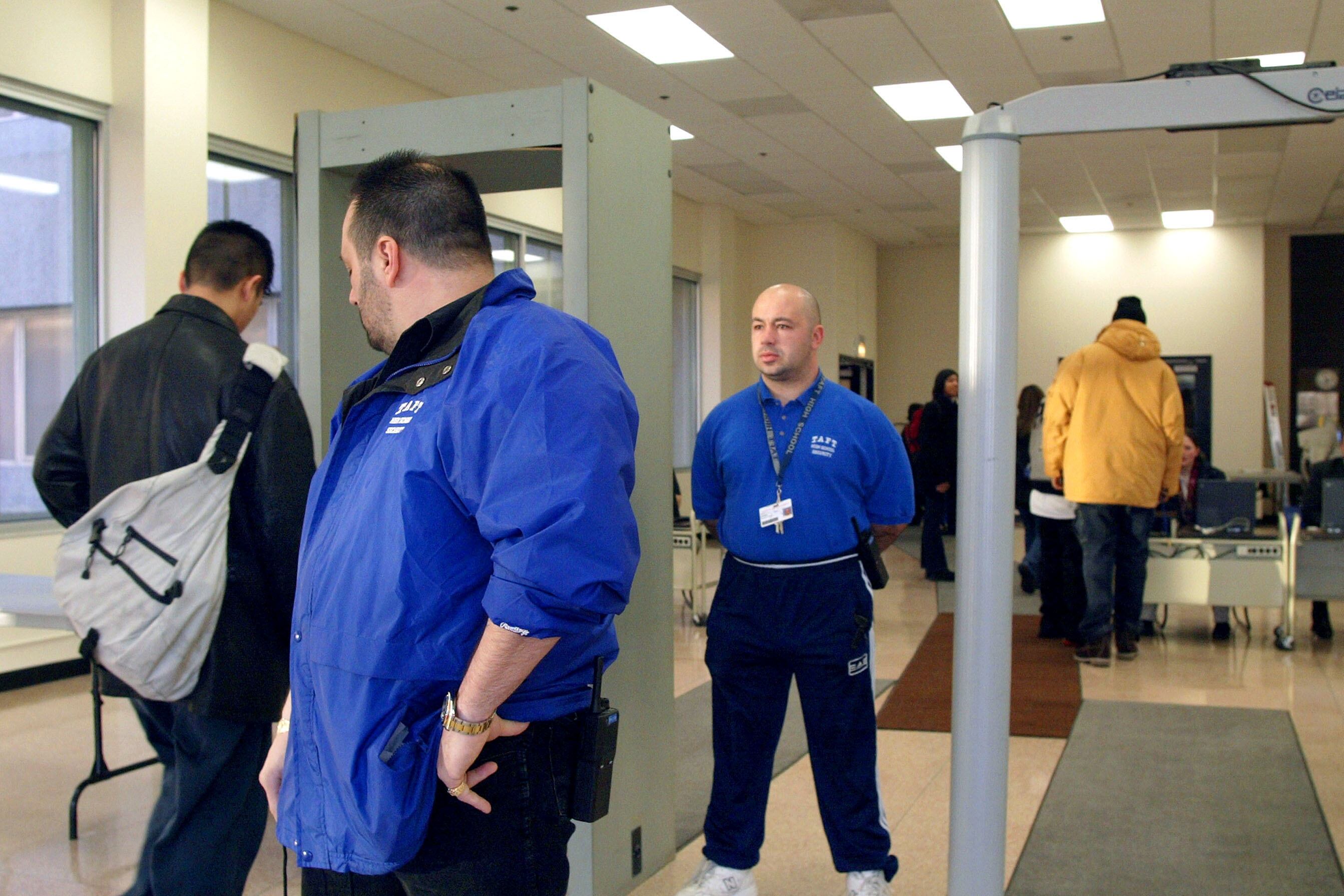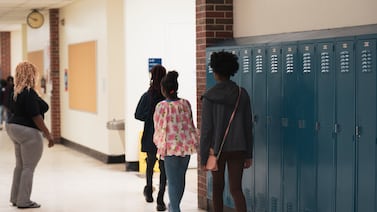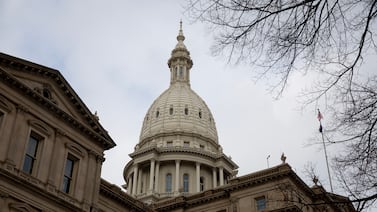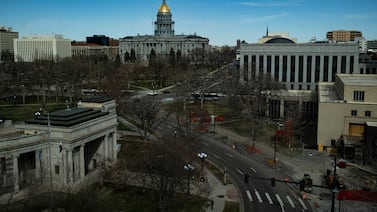Sign up for Chalkbeat Chicago’s free daily newsletter to keep up with the latest education news.
Chicago high schools that removed police in the last few years saw a slight dip in the most serious types of student disciplinary violations, according to a new study released Wednesday.
The study, from the University of Chicago Consortium on School Research, comes as Chicago Public Schools plans to launch a new safety policy for the upcoming school year that will unilaterally remove school resource officers, or SROs, from all campuses.
The study’s authors looked at the district’s more than 80 CPS-run high schools, and focused on those that removed officers after the summer of 2020, when the Chicago Board of Education directed Local School Councils to decide if they wanted SROs on campus.
As of last school year, 39 high schools had on-campus police officers staffed by the Chicago Police Department, while 44 other schools had none, according to the study. Fourteen schools had voted since 2020 to remove them. The Board of Education plans to remove the remaining officers starting this fall.
The study’s authors examined different data points, such as discipline and how kids and teachers felt about their schools, before and after those campuses got rid of police officers.
“On average, on the whole, there weren’t that many changes or differences between schools that had removed SROs and schools that didn’t,” said Amy Arneson, senior research associate with the consortium. “And so the significant changes we did find were improvements.”
The authors found that schools that shed SROs saw small drops in high-level disciplinary infractions compared to the 2018-19 school year, when they still had officers. These incidents include student actions that are “very seriously” or “most seriously” disruptive or are illegal, such as threats or actual violence and anything involving alcohol, drugs, and weapons. High-level infractions generally rose across CPS between the 2018-19 and 2022-23 school years, the study said.
While schools without officers now had fewer high-level disciplinary violations compared to before the pandemic, those more serious incidents rose between the 2021-22 and 2022-23 school years — but not as much as schools that still had officers, the study found.
That drop could be the result of the district pushing schools to embrace alternative disciplinary practices and work on building a positive culture in school, said Jadine Chou, CPS’s chief of safety and security. She acknowledged that it’s hard to know for sure, since the study did not explore why these changes happened.
When schools first began removing police officers, the district gave them funding to use toward things such as restorative justice and hiring security guards. A separate University of Chicago study last year found that schools that implemented restorative justice practices saw fewer student arrests.
At the same time, the study notes, schools that got rid of SROs already had a relatively low number of disciplinary infractions, while schools that kept their officers had higher such incidents.
There were no significant changes, however, when considering all types of discipline or suspensions at schools that got rid of campus police, according to the study. Less serious disciplinary violations can range from running in the hall to displaying a gang affiliation or getting into a fight that results in no injuries.
Also, there were no notable differences in police notifications, which are calls made to police when a student does something that warrants police involvement, per the Student Code of Conduct. Those notifications are typically not the same as 911 calls, Arneson said.
While students across all schools reported feeling less safe after the pandemic, there were no notable changes at schools that got rid of SROs, the study found. There also were no significant differences in how safe teachers felt, as well in how much students trust their teachers.
Implementing the new plan won’t ‘be a light switch’
Earlier this year, the Chicago Board of Education directed CPS CEO Pedro Martinez to create a new school safety policy that would ban SROs from campuses, effectively stripping LSCs of the power to decide. State lawmakers proposed a bill that would allow LSCs to contract with the Chicago Police Department in order to bring officers to their schools, but that bill was stalled.
The new school safety policy, which the board is expected to vote on in July, will require teachers and staff to get more training on restorative justice practices, which are alternatives to discipline and are meant to resolve conflict. That policy also emphasizes pairing students with more mental health resources.
Chou, the CPS chief of safety and security, said the study signals that “many other things” beyond the presence of police define what makes a school feel safe and CPS will have to work to understand what those factors are as officials implement its new safety plan.
At some schools, that could simply mean improving traffic around the school. At others, it could mean partnering with the Chicago Police Department to help with arrival and dismissal because of concerns about violence in a particular neighborhood, Chou said.
“This is not going to be a light switch, turn it on and everything will fall into place,” Chou said. “We realize that we’re going to have to do a lot of community engagement to understand what those needs are, and that’s one of the biggest components of whole school safety, is the engagement aspect.”
The new policy would require every school to make its own safety plan that follows some broader guidelines, such as removing police officers and getting training in alternative discipline practices.
Dwayne Truss, a former member of the Chicago Board of Education who advocated for giving LSCs the power to make decisions about their on-campus police, said there hasn’t been enough engagement with school communities. The board should have waited to make changes to the safety policy until after this study was conducted.
“I just want to be very, very clear: I’m not pro-SRO, anti-SRO; I’m just going to be against usurping the rights of Local School Councils,” Truss said. “And this is data that you share with people and have discussions with people to help educate them on what’s the best path forward, what are some of the best practices.”
For the district’s part, it collected about 9,000 responses to its proposed new safety policy, which it created in partnership with community organizations.
There were also some distinct characteristics about schools that chose to keep their SROs versus the ones that didn’t. In the 2018-2019 school year, before the board decided to let Local School Councils remove SROs, a similar share of students across different races attended a school with at least one officer, ranging between 87 to 93%.
By the 2022-23 school year, two years after schools started removing SROs, nearly two-thirds of Black high school students attended a school with at least one SRO, while the same was true for just 29% of white and Hispanic students and 22% of Asian American students. Students with disabilities, those from low-income families, and students who were native English speakers were also more likely to be enrolled in a school with an SRO.
High schools that had more reported disciplinary infractions were more likely to choose to keep their SROs, the study found. Also, smaller schools and those that enrolled smaller shares of students from low-income families tended to keep their SROs.
Arneson said the study released Wednesday is the first of a series that will examine the district’s approach to school safety. This first piece of research looks at the impact of removing SROs, but doesn’t explain reasons behind the findings, she said. Those questions will hopefully be answered in future studies related to school safety that the team plans to publish in the future.
Arneson wasn’t surprised by the findings, which she said followed the trends of some other national studies. There are still lots of questions to explore, she said.
“Now that there’s no SROs across CPS starting next year,” she wondered, “what are the differences that we’re seeing in schools that didn’t opt in to removing them up front?”
Reema Amin is a reporter covering Chicago Public Schools. Contact Reema at ramin@chalkbeat.org.






